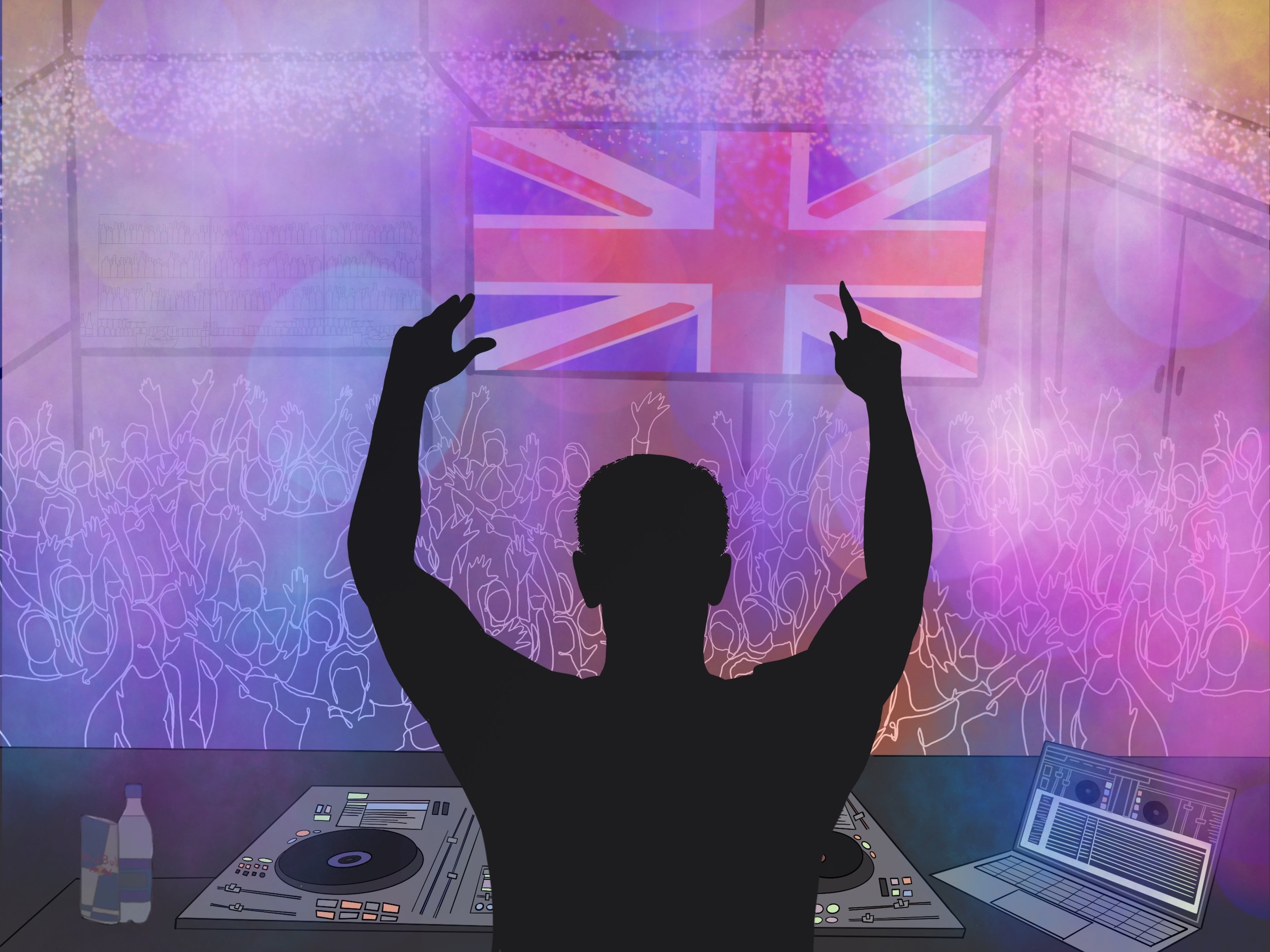What do you know about UK Garage?
Celebrating the history of some of the UK’s most underrated but pivotal genres.
artwork by Tanaya Vohra.
What do you think of when you hear the words “British music”? For some, it may be the Beatles. Others may think of Adele, or for TikTokers, maybe even Central Cee. Regardless of your musical taste, it is fair to say that the relatively small island of Britain has made a profound impact on the global music scene.
London is one of the most global and diverse cities on the planet. With a rich history of immigration, London has become home to cultural diversity—the proverbial melting pot, as Americans like to describe it. The influx of people from across the world has introduced new cultures, languages, and perspectives, redefining understandings of what it means to be ‘British.’ The impact and legacy of migration are clear, and one of the biggest signifiers is within the UK’s music scene.
As a form of artistic expression and creativity, music is an industry where influence from the black diaspora is most prevalent. Skepta, Stormzy, and Dave are international superstars, published on magazine covers and performing on global tours. However, we often fail to ask the question: How did they get there, what enabled their rise to stardom, and who came before them?
UK garage and funky house are some of the most popular genres in British music history, and are fundamental to the modern industry. The two genres are closely related and have a distinct, electrifying sound, and even though many of the greatest hits were released in the 90s and early 2000s, they are timeless in social and party settings. I love the genres, and I have included a breakdown of the history alongside a brief synopsis of the most influential artists. As always, I have attached a short playlist at the end that includes some of my favorite songs.
The Birth and Growth of UK Garage (UKG)
As a student at UChicago, it is hard to avoid being told that Chicago is the home of house music. Chicago gave rise to this global music genre, and its spread across the United States ultimately inspired the British scene. Garage music was born from house and was particularly popular in New York. The genre took its name from the night club “Paradise Garage”, which pioneered the unique sound during the 1980s. Alongside house, early hip-hop, disco, and pop rock also influenced the genre.
The New York scene grew during the late 80s and early-mid 90s. Songs like “Closer than Close” by Rosie Gaines and “Push the Feeling On” by the Nightcrawlers experienced great success and may remind some of my older readers of the good old days! With the rise in the genre’s popularity, British DJs began playing mixes of the most popular US tracks. By increasing the tempo and focusing on baselines, they began to create their own sounds.
Rising alongside UK Garage was Jungle music, a predominantly black art form that served as the foundation for what is presently known as drum and bass. A genre under the umbrella term electronic dance music (EDM), jungle was heavily influenced by reggae, hip-hop, dancehall, and funk sounds, and also gained tremendous popularity in the UK’s rave scene during the late 90s. Unlike garage, which typically had tempos around 130 BPM, Jungle was significantly faster, with most songs at around 160 BPM.
With growing popularity during the 90s, UK garage reached its peak at the turn of the century. From 1998 to 2000, British DJs firmly established their own sound, and the genre was often played on both pirate and commercial stations. The genre also transitioned away from the traditional sound. Not to get too technical, but for my music nerds, garage previously followed a style called “four to the floor,” but in this period, it transitioned more towards 2-step. Four to the floor has a bass line with a kick drum pattern that follows a 4/4 time signature where the kick hits evenly four times per bar. 2-step, on the other hand, serves as a broad term for beats that don’t follow the four-to-the-floor pattern, like those that include syncopation or triplets. This transition to 2-step gave rise to the genre’s most famous artists, such as Craig David and Artful Dodger, who soon took over the scene, mixing smooth R&B vocals with heavy basslines. The genre experienced significant success both underground and commercially during this time, and its period of prominence has retrospectively become a seminal period in British music history.
The Downfall
Despite the successes of both groups and individual stars, the popularity of UKG began to dwindle towards the end of 2000/early 2001. There was a transition away from the sound, and production techniques shifted to lay the foundations for grime music, one of the UK’s most unique and famous genres. Although MCing existed in the garage scene, grime was more heavily focused on wordplay and lyricism than on the instrumentals and basslines. Grime beats have a distinct sound but took great influence from the previous electronic genres.
Similarly, jungle music also rose and fell very quickly. While some see this as a result of the fast-moving nature of trends, others understand it to be a product of anti-black racism. As formerly mentioned, jungle was a genre predominantly built by black British artists, which drew together large audiences of young black people. Such gatherings often attracted significant police attention, depriving jungle of some freedoms enjoyed by other genres. Although jungle fell from prominence, the genre was, in essence, rebranded and repackaged as drum and bass and soon became spearheaded by predominantly white musicians. The music was similar, but it faced significantly less backlash and social pressure relative to jungle and, as a result, thrived for longer.
The Resurgence – UK Funky
Although the peaks of UKG and jungle were short-lived, they did see somewhat of a resurgence in the mid-2000s. Alongside the growing popularity of grime came UK funky, an extremely popular subgenre that saw great success on a commercial level. UK funky combines sounds from UKG and jungle with further African and Caribbean influences. Originating in 2006, UK funky experienced its prime between 2007 and 2009 and became very popular both in clubs and on the radio. Without realizing it, you have probably heard “Do You Mind” by Crazy Cousins before, as it was directly sampled on Drake’s number 1 hit “One Dance” from 2016. UK funky sounds stayed popular during the 2010s, but the subgenre ultimately receded from the spotlight like its predecessors.
The Legacy
While, unfortunately, the popularity of several of the UK’s most original, unique, and loved genres in UKG, jungle, and funky were short-lived, their impact on the modern-day music industry cannot be understated. They were fundamental to the creation of many modern genres we enjoy today, and many artists continue to embody their legacy through the sounds and techniques used in their musical production. A notable example is Disclosure, who have over 18 million monthly listeners on Spotify and often incorporate similar techniques to UKG. In addition, grime has continued to define the British music scene. Skepta, Wiley, and Stormzy’s international success are all products of their grime success, which cannot be divorced from UK garage, jungle, and funky house, historical genres that redefined the UK music scene.
Myles’ Top Picks By Era (these are all on my playlist too!)
Early Garage sound:
Rosie Gaines – Closer than Close
Tina Moore – Never Gonna Let You Go (Kelly G Mix)
Nightcrawlers – Push The Feeling On
UKG:
Craig David – Rewind
Artful Dodger – Movin’ Too Fast
Sweet Female Attitude – Flowers
Artful Dodger – Please Don’t Turn Me On
DJ Pied Piper – Do You Really Like It?
So Solid Crew – Envy (They Don’t Know Vocal Mix)
UK Funky:
Egypt – In The Morning
Fish Go Deep – The Cure & The Cause
Meleka – Miss Me
Legacy:
Disclosure – You & Me
T2 – Heartbroken
Katy B – Lights On
edited by Alex Malm.
artwork by Tanaya Vohra.

